For artists, when you get that incredible uncomfortable feeling it might be – no, it is – a good thing. Johanne Mangi explains.
The Cringe Factor
BY JOHANNE MANGI
Every day my head is filled with thoughts and ideas. Just when a really great idea (in my humble opinion) comes along I think that’s the last good idea I’ll ever have and life will never be the same. The well has gone dry. But, lo and behold, the very next day or after another great idea pops up! Since I don’t want to go to my grave with all these thoughts spinning around in my head I figured now would be as good a time as any to start sharing them.
My favorite is what I call “The Cringe Factor.” You know what I’m talking about; you just might call it something else. It’s that incredibly uncomfortable feeling we get when something that seemed so right turns so wrong. You’re embarrassed for yourself. The funny thing is you may be the only one who knows! I’ve come to realize that this feeling can actually be a good thing.
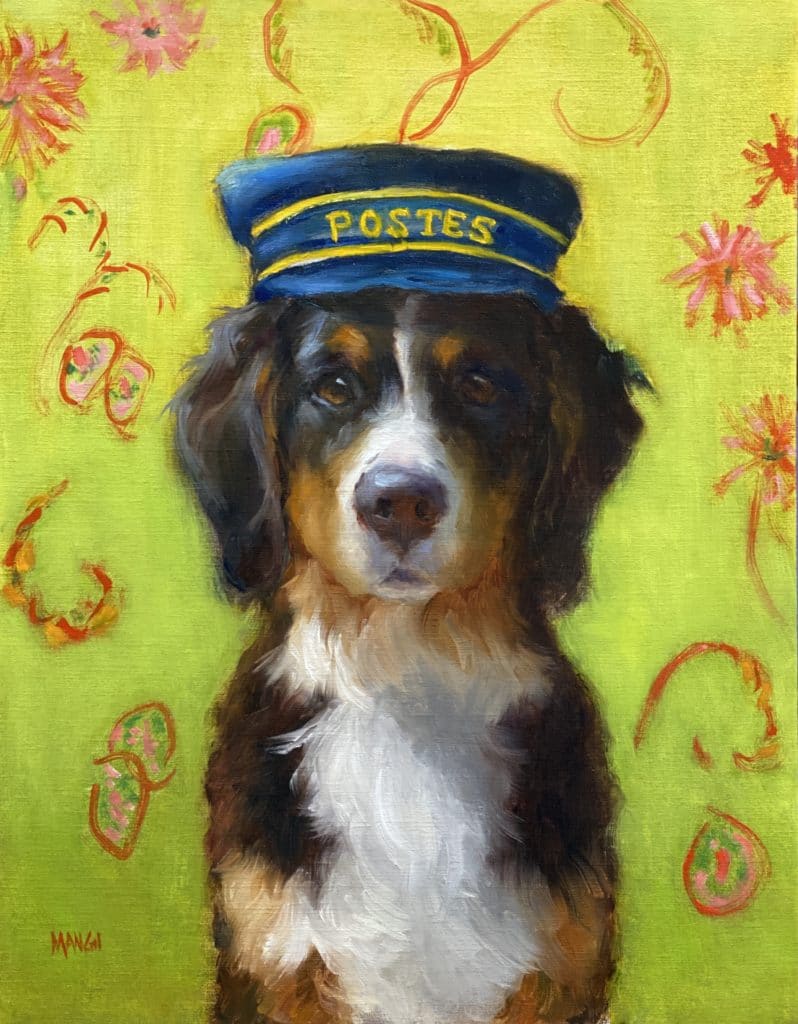
It gives me the impression that I’m living on the edge. I’ve pushed the limits. This is hilarious especially since personal safety is a priority of mine. You won’t catch me bungee jumping off a cliff or skydiving any time soon no matter who says it’s safer than driving your car. This is within my realm of risk.
In regards to painting I think you should embrace that cringing feeling. Don’t run away or avoid it. Get to know it! It will truly be your best friend. If you’re not cringing you’re not trying hard enough. You’re playing it safe. You’re not painting boldly. You’re not using a brush that’s too big. You’re not throwing your body into it (not literally). You’re not using enough paint. You’re not making enough MISTAKES!!!
If you’re going to criticize your work anyway you might as well go for big mistakes. The bigger the better. Why? Because if it’s really big I doubt you will ever do it again! But it will have gotten your attention and you will learn from it. We all would like to be a better version of our painting selves. Every day I get up with the hope that this will be the day.
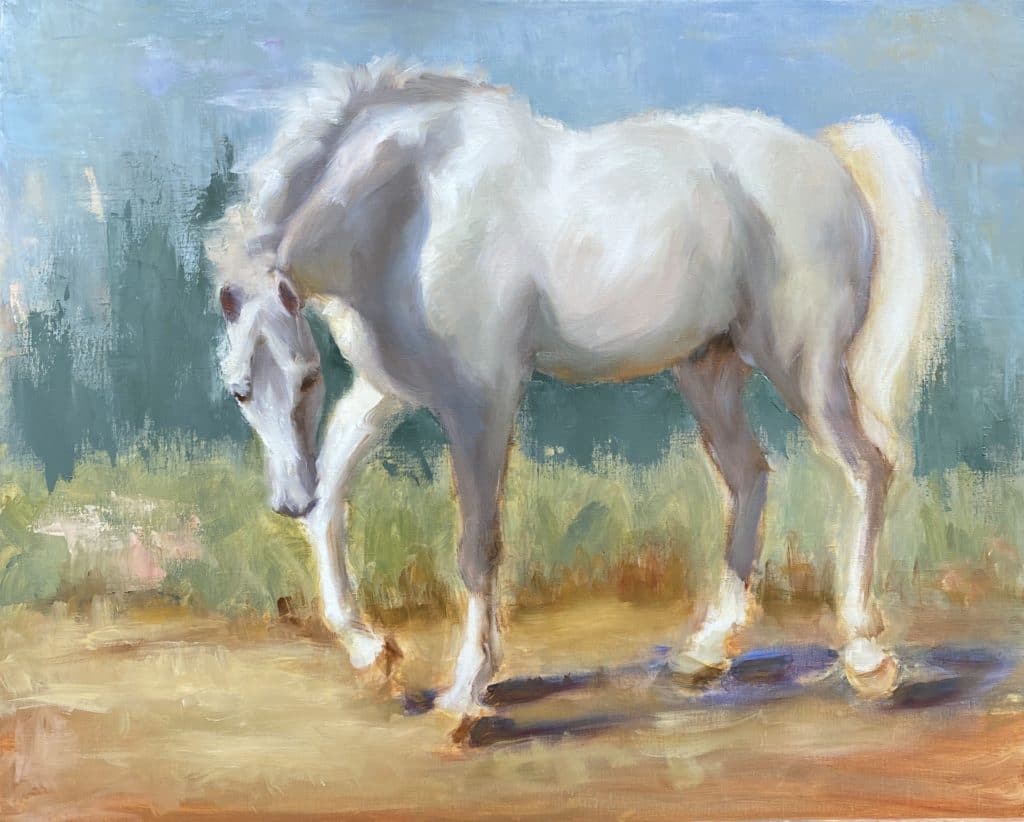
Whenever I’m painting I always figure the best thing I can do is simply put something down on the canvas. ANYTHING. It really doesn’t matter what. I don’t worry about OUCH moments. I might have to wipe it off but it’s more important to get over the hump. I started!
As a matter of fact I’m a big proponent of wiping. Not just in the tonal sense but in a way that takes away evidence!`Sometimes I wipe a bit too soon but it’s quite cleansing.
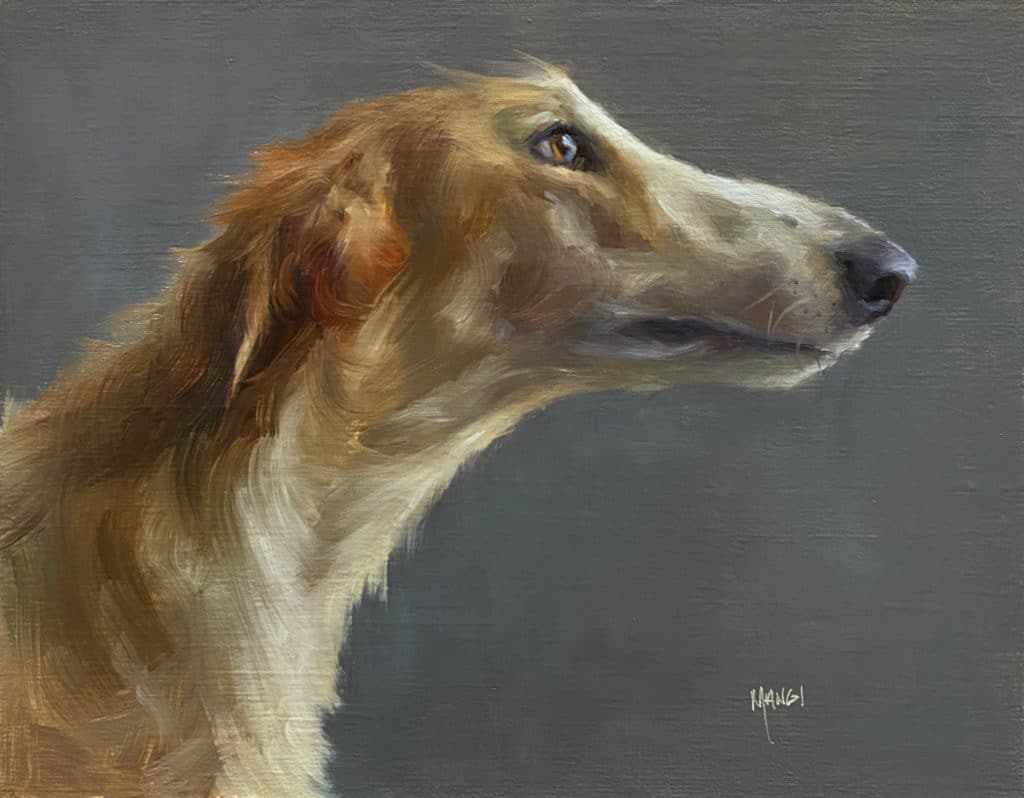
A True Story
I just finished a painting and signed it even though I thought there was something off about it. Truth be told this is not an unusual occurrence for me. I occasionally sign paintings before they’re finished, especially if my energy has waned towards the painting. It helps me mentally shift away from it so I can look at it more objectively. Sometimes I just have to feel I’m done even though I’m not.
When I finally did figure out what wasn’t working on this particular painting I realized I had two options. The most drastic option was actually the simplest (I’m still cringing over the very thought). Unfortunately, it involved wiping the most perfectly painted eye.
I took about 10 seconds to decide and then whoosh (YIKES)! It was gone! I sucked in my breath. I couldn’t even believe I did it. Did I take a photo? What if that was the best I could do? I knew I could do it again. At least that’s what I told myself. This is living on the edge for me. While others are climbing El Capitan I choose to limit my risks to manageable ones in the studio.
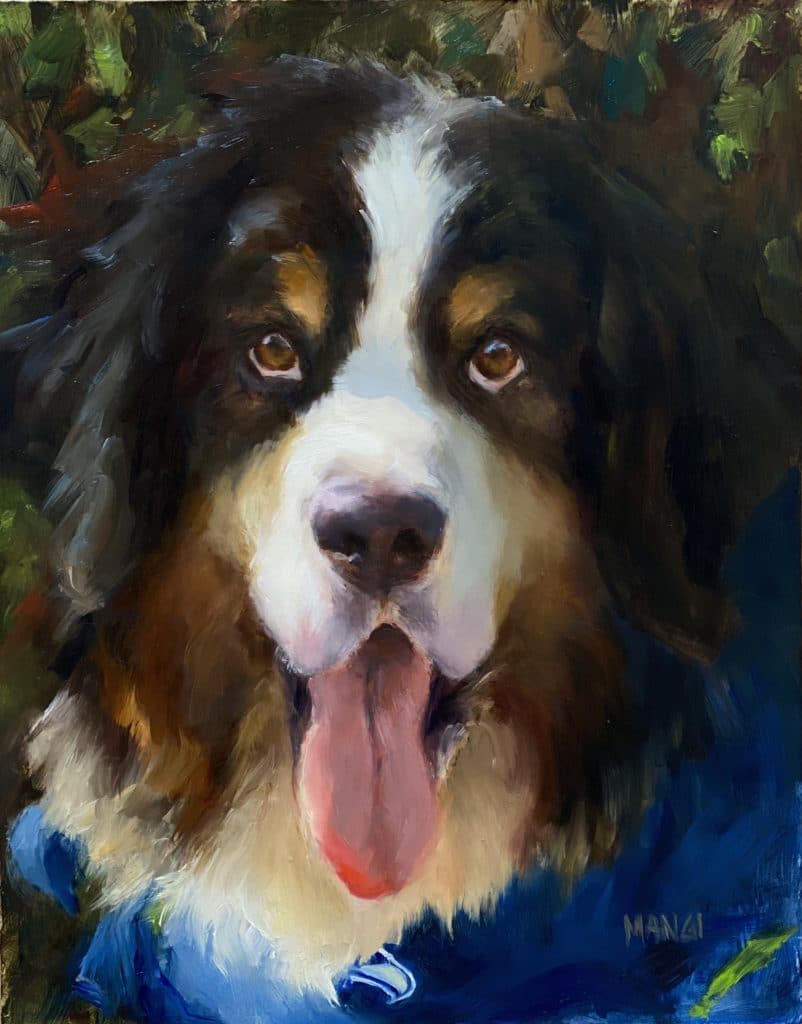
Growth comes from challenges. Challenges can make you uncomfortable. Being uncomfortable can make you cringe. Cringing can bring about positive change. Really. I’m not making this up. I’ve been cringing since high school. One other thing, no one KNOWS you’re cringing. It’s yours alone. I doubt anyone is staying up at night worried about your moment of discomfort. They’ve got their own to think about!
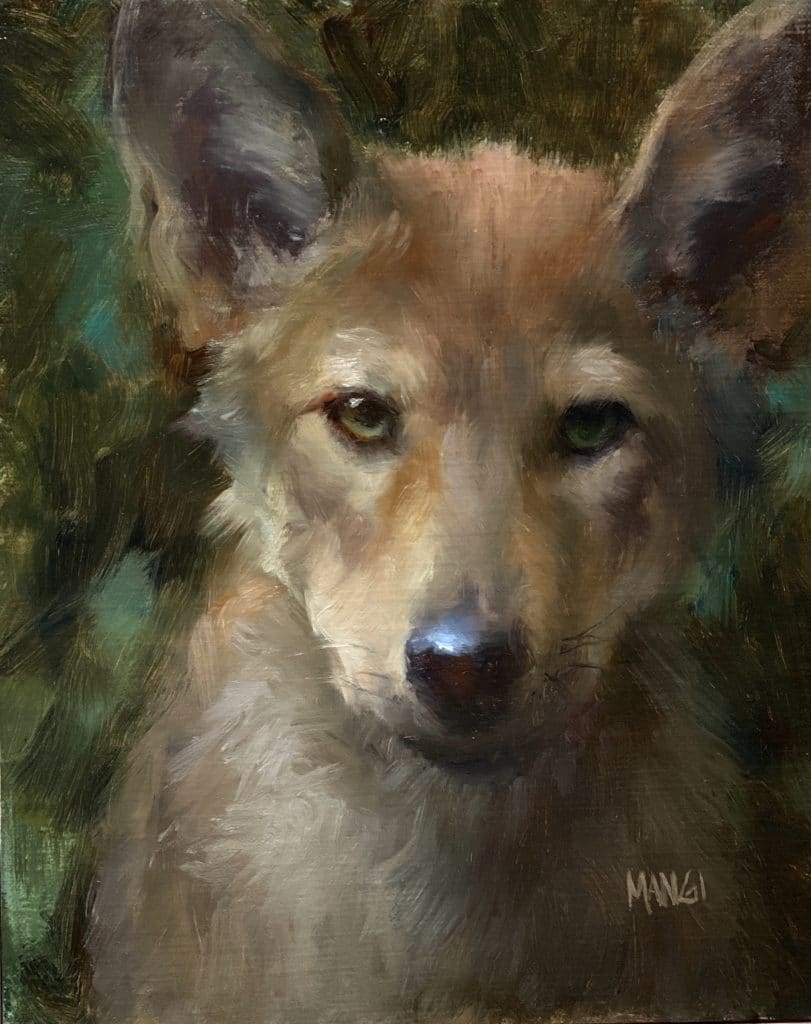
How do you feel about “the cringe factor” when it comes to painting? Share your experiences in the comments below.
Learn more from Johanne Mangi, including how to paint horses and dog portraits, in her art video workshops. “The Fine Art of Painting Dog Portraits” and “The Fine Art of Painting Horse Portraits” include over 11 hours of in-depth instruction! (Preview them below)
.
.
There are plenty of painting tips, techniques, and strategies to be uncovered in this training, which will help you create beautiful, emotionally impactful portraits of dogs and horses. Click here to learn more about the Johanne Mangi Combo Set.
> Click here to subscribe to the free newsletter, Plein Air Today
> And click here to subscribe to PleinAir Magazine so you never miss an issue!

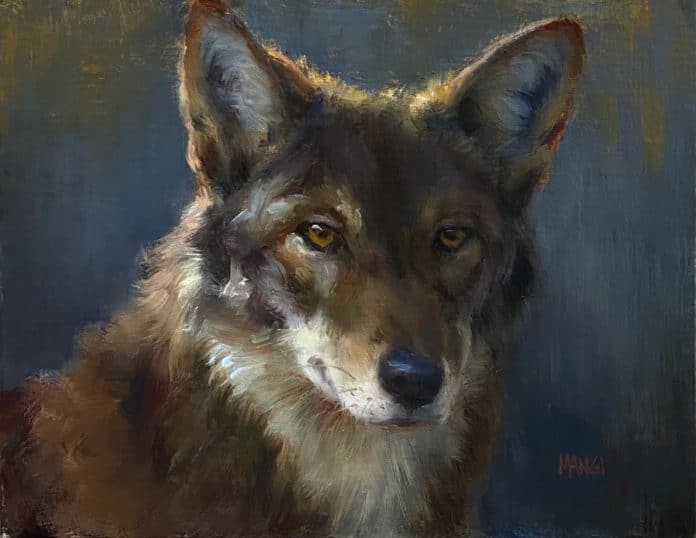



Such good and helpful advice, Johanne. Your work is beautiful, and you are an inspiring teacher.
Wise words. One must be willing to be in over one’s head, and if one is attempting to express deep feelings, or subtlety of any sort, there will always be the possibility of embarrassment. Nothing risked, nothing gained. Playing it safe can be a serious problem.
I a bit puzzled by what you mean by cringe or cringing, however. From what you are describing in your article, it seems to mean a kind of shame that one feels when one has painted in an incompetent way. I would agree that one must learn how to jump in and be willing to fail, so that one can really go forward. This is true, and I am reminded of it as I soldier on as an artist. I will embrace that feeling when it happens, and learn, so I thank you for reminding me.
But to many people, to cringe is to be embarrassed by bad taste or cluelessness. An example might be that uncle at the wedding who earnestly makes a speech about the bride’s former boyfriends, or ex-husband. Even if he has sincere tears in his eyes, everyone else is, well, cringing.
This lack of common sense in art is a serious problem too, and can make one’s audience feel much like the mortified wedding guests. One should learn, as artistic development proceeds, to know when a painting has gone from heart-felt to maudlin. One should learn, or at least try to learn, why some imagery and perhaps even some formal elements are to be avoided. Bad taste is a serious problem, especially nowadays when so many artists are learning how to draw and paint accurately, but have no sense whatsoever of the difference between noble feelings and ludicrous sentiment. Perhaps the best way to study taste is to study art history, music and literature. It is not easy to define bad taste and good taste — but one should learn to recognize it when it appears, and it can be found in the best art.
I conclude thus: your last picture here has, to my eye, a certain beauty, quality and nobility that the previous dog (with the big tongue) and the painting of the white horse lack. Maybe that’s your whole point — if you want the make the beautiful painting of the last dog, one must be willing to make the other one. Is this what you were saying, or am I off?
Thank you for your excellent and thought-provoking article.
John Morra
Regarding the “cringe” factor, I think trying something that you haven’t done before can cause you to cringe as you approach the finish of a painting. The questions for myself on any drawings or paintings are: Have I done the best that I can do? Is it time to stop? Will I mess this painting up if I keep on going?
When I get to this point, I usually decide that my painting is finished. I set it aside and go do other things to give myself a break. When I come back to it an hour, 2 hours, or a day later I can be more objective and I either see something that needs a touch-up, or it really is finished. I too sometimes sign my name before it’s done, usually because I need to make sure I have left a good space for my signature within the painting.
The only way to grow as an artist is to try painting something you haven’t done before. You can grow stale as an artist if you keep doing things over and over again without thinking. I know practice is necessary for improvement, but try new mediums, use a palette knife rather than brushes, do plein air painting, not just studio work. I have done very little drawing or painting outdoors and I’m working up my courage to get out there!
Thanks for getting me thinking.